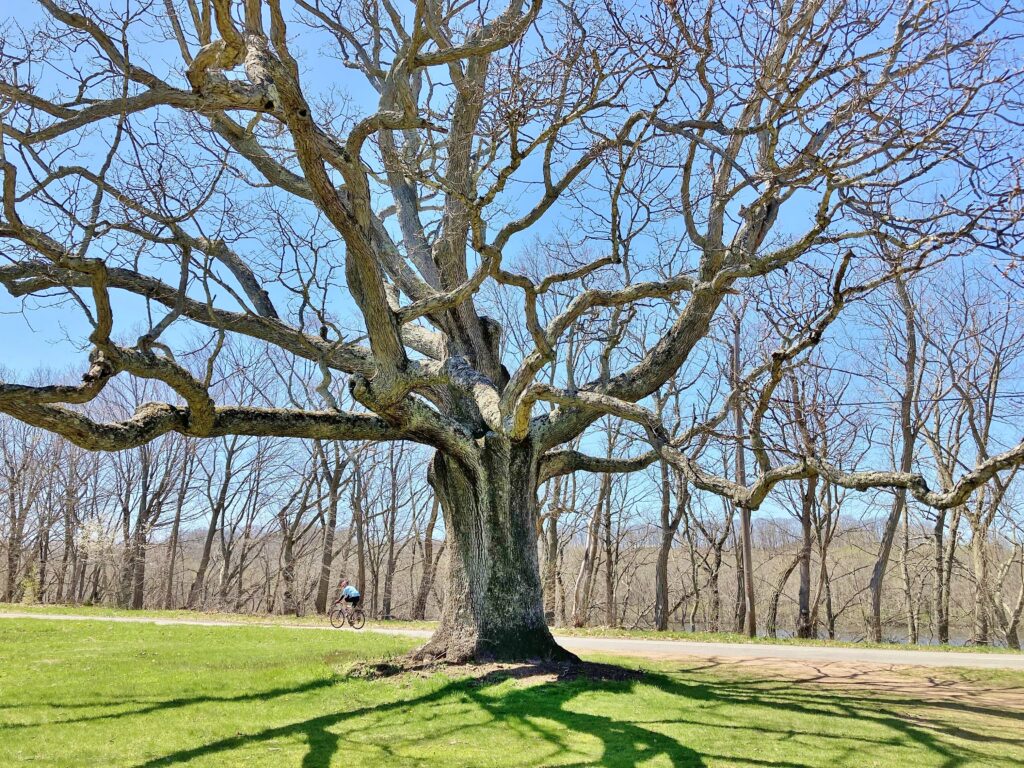by Bruce Bowan
A prominent white oak grows at the crossroads of Tryon Road and Old Maids Lane—a silent observer to potentially centuries of transformation of its environs. Few trees boast the stature and significance of the majestic white oak (Quercus alba). They are appreciated not solely for their magnificence but also for their pivotal role as keystone species, white oaks foster a web of life that stretches well beyond their soaring branches. These forest titans, with a potential lifespan of an amazing 500 years, provide unmatched support to a diverse array of life forms, emerging as unsung heroes of the natural world.

The white oak serves as our state tree, symbolizing our resilience and devotion to freedom. It was a source of inspiration for our colonial ancestors, fueling their determined resistance against tyranny. In 1687, a cavity within Connecticut’s famous Charter Oak, a white oak, was used as a hiding place for the Connecticut Charter of 1662 to prevent its confiscation by the British. Its wood is revered for its strength, beauty, and rot-resistant quality, and it represents an exceptional value to woodworkers. Its wood is widely used in multiple applications from boatbuilding to cabinet and furniture making, flooring, and more.
A white oak’s unique ability to sustain a thriving food web is at the heart of its ecological significance. Entomologist Doug Tallamy, a professor at the University of Delaware has highlighted the crucial role of white oaks in supporting 511 known species of caterpillar populations, which in turn form the foundation of part of our food supply and many food chains. Caterpillars, the voracious larvae of pollinating butterflies and moths, are a vital food source for countless species, including birds and small mammals. White oaks provide sustenance for more caterpillar species than any other tree in New England, making them a linchpin in the delicate balance of the food web.
White oaks and caterpillars have a relationship that underscores the concept of ecological interconnectedness. As caterpillars feast on the nutritious leaves of white oaks they become a veritable banquet for insect-eating birds. This supports the survival of avian species and contributes to overall biodiversity. This multitude of caterpillars feasting on a white oak turn into moths that are pollinators sustaining a broad array of plant life. Without white oaks, this delicate dance of life would be disrupted, leading to a potential cascading effect on the entire food web. The white oak’s acorns serve as a critical food source for various animal species. The oak’s mast, the collective term for its nuts, plays an integral role in the survival of numerous wildlife populations. Squirrels, deer, and many bird species heavily rely on these nutrient-rich acorns as a staple in their diets.
White oaks help mitigate climate change through carbon sequestration. These trees function as nature’s carbon vaults, absorbing and storing substantial amounts of carbon from the atmosphere. Their longevity, large canopies, and expansive root structures make them allies in the fight against climate change. The trees are very slow-growing and need protection so they can play their role in the ecosystem.
This notable white oak stands tall in a Town-owned open space land at the corner of Tryon Road and Old Maids Lane. To enhance the appreciation of this notable tree, a bench has been thoughtfully placed underneath the spreading branches of the white oak by Glastonbury Parks and Recreation to benefit residents and visitors. This simple addition invites passersby to take a brief rest from their daily activities, allowing them to bask in the serenity of the spot by the Connecticut River in the South end of Glastonbury.
Preserving the health of the venerable white oak is important. Visitors are strongly encouraged to refrain from driving and parking beneath the tree. The consequence of vehicular traffic is soil compaction, which poses a significant threat to the delicate and expansive root system of the white oak, impeding its capacity to absorb essential nutrients and water. To reinforce this message the Town has installed signage on Old Maids Lane, kindly requesting individuals not to park under the tree.

So, the next time you find yourself biking, walking, or jogging in this part of South Glastonbury, sit and rest on the bench beneath the white oak on Tryon Road and Old Maids Lane. Take a moment to reflect on the beauty of that spot and the silent but essential role these trees play in sustaining life.
TALK’s Environment Team seeks to promote conversations about the environment and climate change in our community. We encourage community writing for this column. If you have a related topic that you are passionate about, please send your ideas and suggestions for future articles to: prez@talk-action.org. All articles are archived on the TALK website https://talk-action.org.
